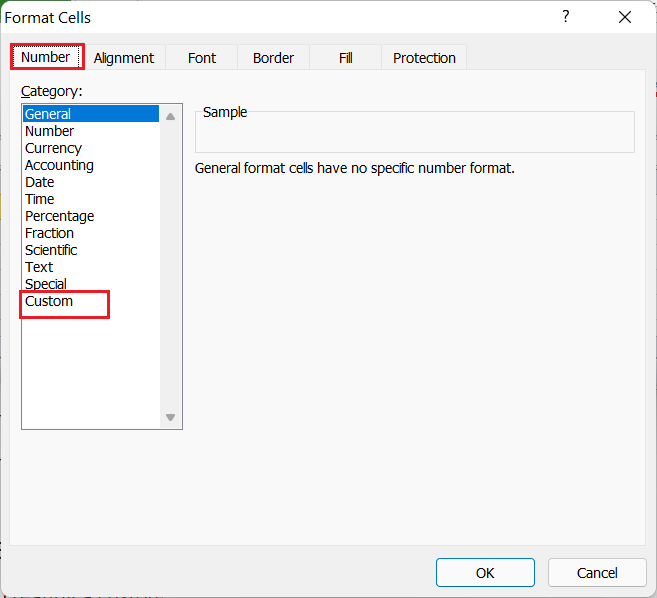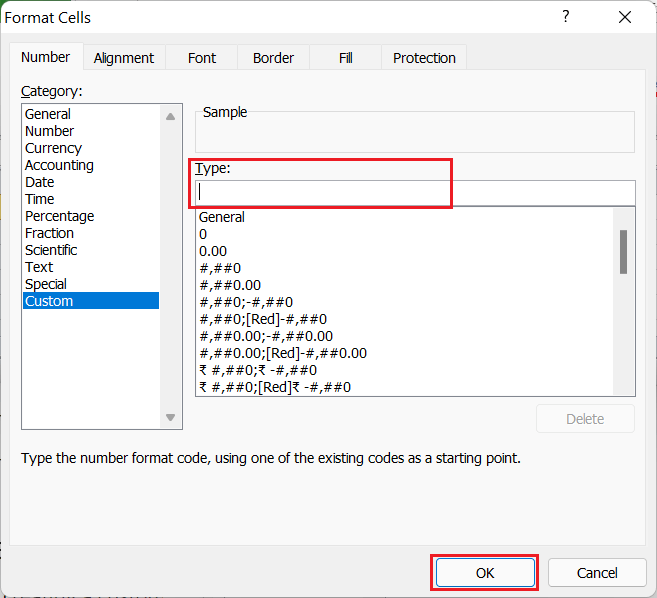Custom Number Format in ExcelMS Excel or Microsoft Excel is powerful spreadsheet software developed by Microsoft by combining all the necessary features, functions, and tools. When it comes to formatting data within a spreadsheet, Excel has several formatting options to format different types of values accordingly. One of the essential features in Excel is to use number format, which enables us to format any numerical value entered within cells. Excel has a wide range of built-in number formats. As a bonus, it also supports custom number formats. 
This article discusses the Custom Number Format in Excel and the required steps to apply it to our Excel sheets. Before discussing the custom number format in Excel, let us first understand the quick introduction of Excel Number Format: What is Number Format?A number format in Excel refers to a specific code or format that controls the way values are displayed within Excel cells. Excel has several inbuilt formats to help us display values in different ways in spreadsheets for Number, Percentage, Currency, Accounting, Date and Time, etc. Example: The following table displays different formats of the same date based on the given or applied code:
The main purpose of the number format is to change the way numerical values are displayed. This does not affect the actual value in the cell, and we can still do the relevant calculations accordingly. In short, the underlying value recorded within the cell is not changed. What is Custom Number Format?Although Excel consists of several inbuilt formats, there may be cases when we want to use our specific format, called custom format. Excel is a powerful tool, and we can create our custom number format. It helps us control the execution of numerical values within the spreadsheet as per our choice. Excel enables users to leverage multiple formatting options that get auto-applied on the desired or selected cells with custom formatting. For example, we might need to automatically format the number 283020000 as $283.02M using the custom number format. Similarly, we may need to format a single-digit value to five digits, even if we only enter a number. Instead of typing 00001, we can set a custom format and enter 1, and leading zeros will be added automatically by Excel. Where can we use custom number formats?We can use custom number formats in many areas within the Excel workbook. It is easy to use them in charts, tables, formulas, pivot tables, and worksheets.
How to access Number Formats in Excel?To access the number formats in Excel, we need to navigate the Home tab and locate the 'Number' group. It looks like this: 
In the above image, these are the built-in number formats. We can click the drop-down icon next to 'General' to access all the common number formats. However, we need to go to the Format Cells dialogue box to access more number formats. Note: By default, Excel applies different number formats automatically on values that we enter within the cells. For instance, if we enter a valid date in an Excel cell, its format will automatically change to the default 'Date' format. Similarly, when we type a value in percentage like 10%, it will be changed to percentage, and so on.How to create a custom number format in Excel?To access all the number formats in Excel or to create custom number formats, we need to follow the below steps:
Structure and Reference of Excel Number FormatTo create a custom number format in Excel, we must know the proper structure of the number format that Microsoft Excel follows. An Excel number format mainly contains the following four sections, divided by semicolons in a sequence: The following code is the typical example of a custom format in Excel: 
Where,
However, the Excel Number Format can have up to four sections. But, only one section is mandatory. Important Rules for Custom Number FormatTo create a custom number format without errors, we must remember the following rules:
Digit and Text Placeholders for Custom Number FormatSome characters in custom number format codes have specific meanings. They generally act as building blocks and can help us create an infinite number of formats. The following table displays the most common formatting codes and their uses:
Theoretically, there are infinite numbers of Excel custom number formats that we can create using a predefined set of formatting codes listed in the table above. Excel Custom Formatting GuidelinesThe following tips or guidelines explain the most common and useful implementations of predefined format codes in Excel: Decimal Places in Custom Number FormatWe can control the number of decimal places using the custom number format. The decimal point location is displayed in Excel number format by a period (.). Besides, the desired number of decimal places is controlled using zeros (0). For instance:
The primary difference between 0 and # in the integer part of the format code is that when we use the pound sign (#) to the left-hand side of the decimal point, numbers less than 1 start with a decimal point. For instance, when we use the format code #.00, the given number 0.25 is displayed as .25. However, the 0.00 format displays the given number as 0.25. The following sheet displays a few more examples of custom number formats in relation to the general format: 
In the above example sheet, it is important to note that the digit placeholders work by following these principles:
Thousands Separator in Custom Number FormatWe need to use comma (,) within our custom number format or code to include a thousand separators. For instance:

Large Numbers in Custom Number FormatAs discussed above, we can use one comma (,) to display a thousand separators. Likewise, we can use two commas (,,) to display millions. For instance, we can use the format 0.0,, "M" to display one decimal place and the letter M next to the given value to denote million. 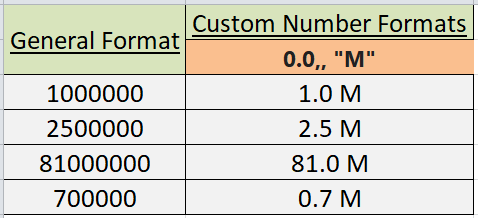
Leading Zeros in Custom Number FormatBy default, when we enter numbers like 05 or 0005 in cells with General formats, Excel automatically removes the leading zero and changes the value to 5. Technically, all three values are the same. However, sometimes, we may need numbers with the desired numbers of leading zeros. The typical method to enter the desired value with leading zeros is to use the apostrophe (') before the value. This means that we need to enter '05 or '005, and the value will be treated as a text string, preserving leading zeros in a cell. 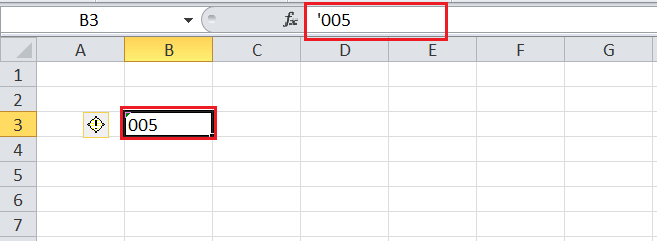
When we want to include specific numbers of leading zeros with many values in a column, it is easy to use a custom number format. As discussed above, zero (0) is the placeholder used to display insignificant zeros. Therefore, if we want to enter numbers up to 7 digits with leading zeros when needed, we can use the custom format code as 0000000 in corresponding cells. After that, if we enter just 5, the value will be displayed as 0000005. The following sheet displays a few more examples: 
Percentages in Custom Number FormatIf we want to display the number as a percentage of 100, we must use the percentage sign (%) within the format. For instance:
The following sheet displays a few examples of the above-listed number formats in relation to the general format: 
Repeat Characters in Custom Number FormatIf we want to repeat any specific character to fill the cell width, we need to include an asterisk (*) before the character. For instance:
The following sheet displays a few examples of the above-listed number formats in relation to the general format: 
Colors in Custom Number FormatExcel also enables users to change font colors for specific value types within the cells. Technically, Excel supports only 8 built-in colors. If we want to use any of the built-in colors in our fonts, we need to type a particular color name in the desired section of the custom format code. But, the color name must be entered as the first item of the specific section. The supported colors are listed in the following table:
For example, if we want only to change the font color but leave all the default or General formats intact, we must use a format similar to this: We can also control the formats in each section and combine the color format with them all simultaneously. For instance: The above format will display general values with colors and applied formats, e.g., display the 2 decimal places, a thousand separator, and show zeros as dashes: 
Conditions in Custom Number FormatWe can also apply the desired formats based on specific conditions. This means we can input conditions, including the comparison operator and a value, and enclose them in square brackets []. The square brackets here represent the conditions. For instance:

Dates and Times in Custom Number FormatExcel date and time formats are based on a specific case with unique format codes. They are not easy to manipulate as many dates and time formats exist. However, we can control dates and times using the custom number formats. For example, suppose we apply the long date format in cell A1 and enter the date as 01-01-2021. It will be displayed as: 
Now, we need to click the OK button and apply the custom number format in the same cell as mm/dd/yyyy, dddd. 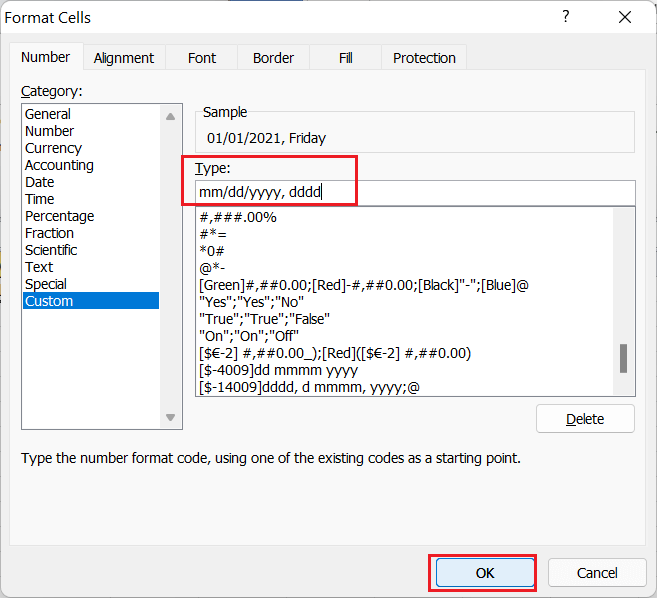
Now, the date will be displayed as below: 
Deleting a Custom Number FormatIf we don't want to use any created number format (custom number format) in the future, we can delete that specific format from the list. For this, we need to go to the Format Cells dialogue box, choose Custom under the Category, locate or enter a specific format/ code in the Type list, and click on the Delete button. 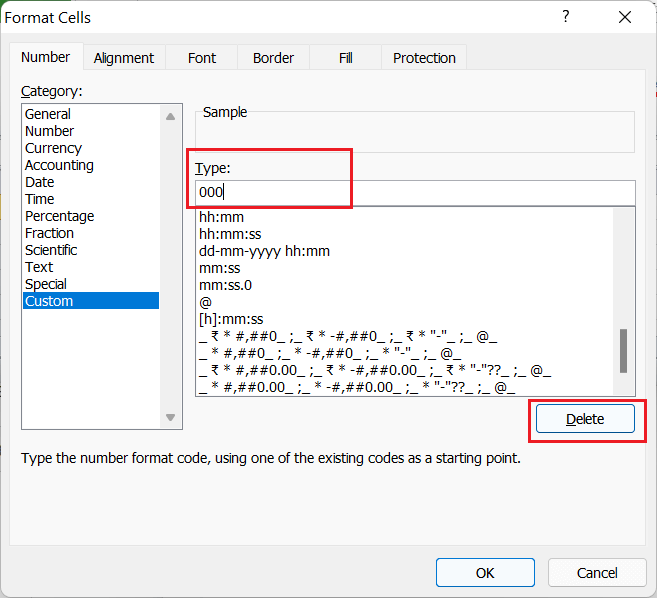
Despite this, the custom number format is stored within the workbook where we apply it. Therefore, if we want to use the same custom formats in another workbook, we must copy the corresponding cells from one workbook to another. That way, the same custom number formats will also be available in a particular workbook.
Next TopicExcel NPER Function
|
 For Videos Join Our Youtube Channel: Join Now
For Videos Join Our Youtube Channel: Join Now
Feedback
- Send your Feedback to [email protected]
Help Others, Please Share





